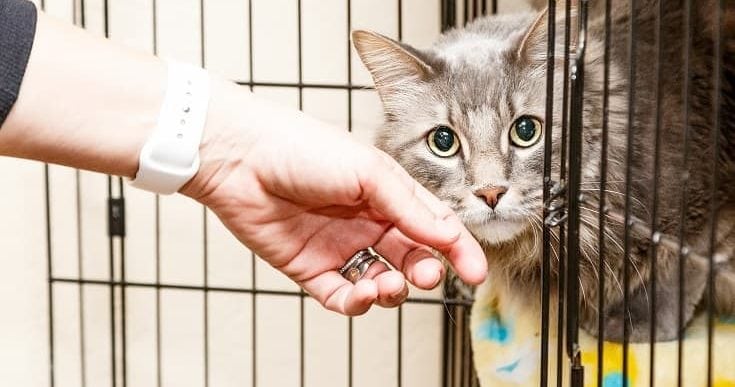
April always welcomes a burgeoning spring. Finally, out of Old Man Winter’s grasp, we usually spend more time outside, and we even be more social with our neighbors since we’re no longer hiding in our shelters. Unfortunately, many animals are still residing in shelters during this month, and sadly even more are in abusive homes. In addition to heralding springtime, April is also unofficially recognized as Prevention of Cruelty to Animals Month by many animal societies across the country. It’s the perfect time to spread the word about the prevalence of animal abuse and step up in your community to see how you can help.
Why Animal Abuse Is Such a Critical Subject
Did you know that it’s almost ten times more likely for an animal to die at the hands of its abuser than be euthanized in an animal shelter? Every year an average 1.5 million dogs and cats are euthanized in a shelter1, compared to the staggering 10 million lives that are lost due to animal abuse2.
Instead of being curled up on a warm sofa, thousands of dogs and cats are forced to experience their entire lives in cages where they’re often not given enough to eat. Many dogs are illegally tethered in the elements regardless of harsh weather, exposed to the worst thunderstorms and even ice and snow. Cats are often neglected for days at a time or dumped on the street to fend for themselves once they’re no longer wanted.
Unfortunately, animal crimes such as dog fighting remain an extreme problem in the United States, and more so in areas where drug trafficking and gang activity are common. For this reason, raising awareness in urban environments is extremely important. And not just for these unfortunate animals. Even small pet dogs are often stolen to be used as bait in dog fights, which means that your dog or cat could easily become a victim if they’re snatched. Animal abusers are also much more likely to commit violent crimes against humans than the general public, so destroying dog fighting rings can also bring down crime rates overall.

 How Can I Raise Awareness for Prevention of Cruelty to Animals Month?
How Can I Raise Awareness for Prevention of Cruelty to Animals Month?
According to the United States Department of Justice, there are over 40,000 professional dog fighters in America3. In 2014, only 10 dog fighting cases were federally pursued—a number that was regarded as an improvement upon the average at the time. This is just one piece of the bigger picture of animal abuse. There’s also a clear connection between animal abuse and the likelihood of domestic violence. Clearly, there is so much more that can be done, and it starts at the local level. Here are a few ideas to motivate your activist spirit:
1. Wear Orange
Bold and bright, orange has been designated as the trademark color for the Prevention of Cruelty to Animals Month. Wear orange all during the month of April to raise awareness, especially if it’s a local humane society t-shirt or merch.
2. Post on Social Media
Instagram, TikTok, and Facebook can all become avenues for social change when we use our skills to make a difference. If you’re artistic, consider creating animal-themed content to grab attention while you supplement your post or feed with facts. For example, you could sketch a dog or cat and list animal abuse facts in the text.

3. Research Animal Cruelty Laws and Procedures in Your Jurisdiction
It’s important to read up on what your local government is doing to combat animal abuse. For example, tethering is illegal in many parts of the country, but not all. Additionally, some animal rescue groups may not be permitted to remove a suffering animal due to privacy laws which could be fought to be revised to allow for necessary intervention.
4. Volunteer at a Local Rescue
You can have firsthand experience in bringing peace to rescued animals by donating some of your time at a local humane society or shelter. Training may be required, so contact the particular shelter for more details.

5. Consider Fostering
If you live in an animal-friendly space, such as your own house or a pet-friendly apartment, you might want to think about opening your doors temporarily for an animal in need. Fostering initiates critical socialization skills for young animals who may not develop properly in limited-access shelter settings. Over time, they should be more relaxed around humans and other animals. This increases their chances of finding a suitable owner, which subsequently reduces the risk of being put in an abusive situation.
6. Remember It Doesn’t Stop in May
The prevention of cruelty to animals shouldn’t stop when April ends and May rolls around. Animal rights activism should take place year-round, and it does on a community level thanks to many national events. For example, the third week of June is considered Animal Rights Awareness Week.

Conclusion
As long as animals remain in dire situations, we’ll recognize April as Prevention of Cruelty to Animals month. You can wear orange and post on social media to raise awareness all month long. Consider volunteering and fostering during the other months of the year as you can to assist with the crisis. We should strive to end animal injustice year-round as the topic vitally impacts our community, especially as animal abuse is often linked to domestic violence, and crimes such as dog fighting can endanger our own pets.
You may also be interested in:
- Animal Rights Awareness Week: When It Is & How It’s Celebrated
- Clear the Shelters: What It Is & How to Participate
Featured Image Credit: KITSANANAN, Shutterstock

 How Can I Raise Awareness for Prevention of Cruelty to Animals Month?
How Can I Raise Awareness for Prevention of Cruelty to Animals Month?





